Roger J. Wendell
Defending 3.8 Billion Years of Organic EvolutionSM


CNMI
The continuing effort to claim the Highpoint of the
Commonwealth of the Northern Mariana Islands!
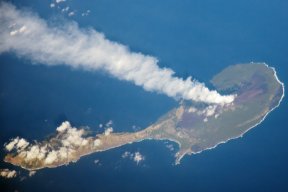 Pagan Island photo by NASA |
Commonwealth of the Northern Mariana Islands
In May/June 2015 I had the pleasure of accompanying the Kaul/Mitchler expedition for the first ascent of Agrihan (also spelled Agrigan) Island. In addition to Agrihan we also spent a lot of time on Saipan, Tinian, Pagan, and Alamagan - spending nearly 50 hours on the M/V Super Emerald for about 800 kilometres (500 miles) of travel by sea. My teammates were Roger and Clint Kaul, John Mitchler, Jeremy Dixon, and Father Morgan Batt. Also joining us, of course, were boat owner Keli Tenorio and her crew, KKMP station owners Gary and Rosemond Sword, and Joe Omar and his machete crew. It was a grand adventure with great people that I'll not soon forget! |
26 Feet From History!
Click on any of these thumbnail images for a larger view:
 1. Me and Mayor Jerome Aldan |
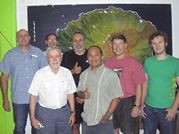 2. At the Mayor's office |
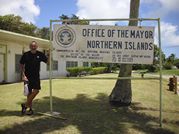 3. Office of the Mayor |
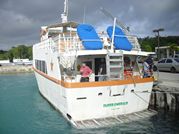 4. Super Emerald |
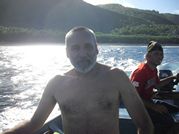 5. Me |
 6. Clint and John |
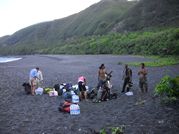 7. Beach landing |
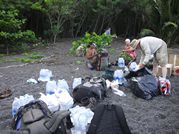 8. Bottled water |
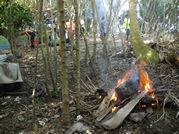 9. Campfire |
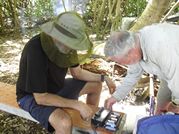 10. WBØJNR, K3TM & the KX3 |
 11. Elecraft KX3 |
 12. WBØJNR operating the KX3 |
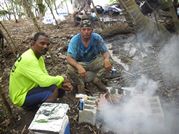 13. Cooking Dinner |
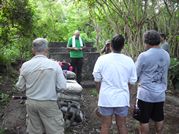 14. Sunday Mass in church ruins |
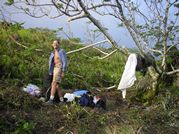 15. "Brids Nest" high camp |
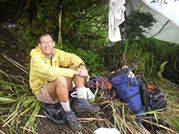 16. Clint covered in flies |
 17. Clint Kaul |
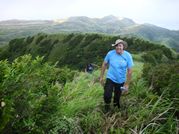 18. Father Morgan Batt |
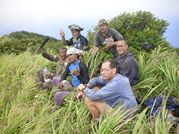 19. Our team of "cutters" |
 20. Me pointing to the summit |
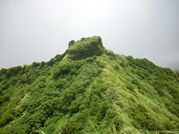 21. The summit |
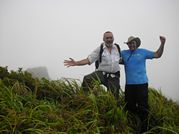 22. Me and Father Batt |
 23. Roger and Clint Kaul |
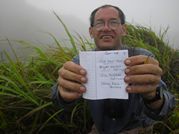 24. Our "near" summit register |
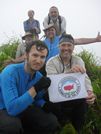 25. Highpointers Club |
 |


| Click Here for a great article by John Mitchler (one of the climb's organizers and an officer in the Highpointers Club) - it appeared in the the club's Apex to Zenith newsletter, Issue # 115, Fourth Quarter 2016 (pp. 15-16) |

Click Here for the rest of the story!

Trip Report by Clint Kaul
Agrihan, Commonwealth of Northern Mariana Islands
INTRODUCTION
The US Highpointers Club works to help its members climb the 50 US state summits. Several members have completed this goal and are looking to climb the US territories and US commonwealths. Starting in early 2015 a few members started organizing a trip to climb Agrihan - the high point of the Commonwealth of Northern Mariana Islands (CNMI). This trip report details their efforts to climb the peak during May 27 - June 4, 2015.PREPARATION
The team started with Roger K, John M and Clint K. To spread the cost of chartering the boat between Saipan and Agrihan we sent out emails trying to entice others to join the team. In the end we had a group of 6 climbers: Roger K, John M, Clint K, Roger W, Morgan B and Jeremy D.
In February/March we started planning the trip in earnest. We first looked at how we would get from Saipan to Agrihan - some 250 miles north of Saipan. We checked with AmeriCopters (http://www.americopters.com/en/) but decided the weight restriction (400-500 pounds at that time) and cost (US$20,000+) would be prohibitive.DANGERS
We also looked for passenger vessels operating out of Saipan using http://boatdb.net/port/saipan-mp.htm. While many boats are listed, we quickly found many are too small to carry several climbers and their gear/supplies. Several other boats are restricted to stay within 20 miles of Saipan. It turns out there are only a few boats which are large enough (60 feet plus) and US Coast Guard licensed to travel to the northern islands. We contacted several boat operators including Blue Marlin, Kaiyu III and the Super Emerald asking what facilities they have, how long it would take to travel to Agrihan and how much it would cost. We ultimately decided to charter the Super Emerald which is a former ferry boat. It seemed to have the best facilities and appeared to be the most comfortable. It has two toilets, a shower, a large air-conditioned interior with benches to sleep on and plenty of storage space. The upper deck is also rather large for communal eating and relaxing.
In parallel we wondered whether we needed permission to land on Agrihan and climb it. Up until 1990 Agrihan had been inhabitated with several families living in a small village on the southwest shore. We contacted the CNMI Congressional Representative and he put us in contact with the Office of the Mayor of the Northern Mariana Islands Municipality (NIMO). Their mail address is P. O. Box 10007, Saipan, MP 96950. In 2015 the Honorable Jerome Aldan was the mayor and the administrator was Lee Kaipat (lee.kaipat@yahoo.com).
Talking with them we found we needed to complete two documents. The first is a Mayoral Authorization for Entry (MAE) to the northern islands (primarily Agrihan and Pagan). Completing the form we listed the Highpointers Club as the lead organization with the stated reason for entering Agrihan being the promotion of reaching some of the highest mountain peaks in the Pacific. We provided full contact information for each climber as well as our entry dates (May 28 - June 6, 2015 - more on this later).
The MAE requires that we obtain all necessary licenses, permissions, etc. For example, US Coast Guard, Fish and Wildlife (there are endangered animals on the northern islands, etc. This is where the second document, a Limited Power of Attorney (LPA), was important. The team leader completed this form which allows the mayor's office to interact with all other government agencies on our behalf and obtain those necessary permissions.
Corresponding with both NIMO and the Super Emerald as well as looking at long-term weather forecasts, we picked a window for climbing Agrihan. The general consensus is mid-May to end-July is the best window. It is after the winter winds so the seas are calm enough for the 20-22 hour crossing from Saipan to Agrihan. Yet it is before the fall storms batter the area.
Based on previous island summit climbs, we decided to charter the Super Emerald for 10 days. We estimated it would take 4-5 days to hack our way up from the beach to the western summit. Plus 1 day to traverse to the eastern peak. Plus 1-2 contingency days for rest or bad weather. Plus 2 days for transit between Saipan and Agrihan. Working with the team of climbers and the boat operator we ultimately chose May 28 - June 6 to charter the Super Emerald.
We scoured the internet for information on Agrihan. We found several pictures, some videos and of course satellite photos. Looking at these we determined at least half the route would be through swordgrass. Us mainlanders were not going to start using machetes to cut our way up. Working primarily with the boat operator but also with NIMO we decided to hire 5 locals to support the team of 6 climbers: Omar, Patrick, Vince, Tony and Lawrence. The idea was to have a team of 3 cutters and 2 supply carriers who would rotate duties throughout the day to rest their arms/legs respectively. Unfortunately, this idea didn't work out. The supply carriers stayed with the cutters instead of descending and carrying up new supplies for the team. Some of the climbers ended up ferrying the supplies up the mountain.
MAY 26-27, 2015 - Saipan - Preparation Over the last day or two the climbers have been flying into Saipan. We arranged for two meetings during this time. The climbing team meets with NIMO to sign and exchange the final MAE paperwork. We also meet with the Super Emerald boat crew and the local team of cutters and carriers. We are given permission to load our supplies on the boat in the evening. This mostly consists of water (roughly 5 liters of water per person per day) along with food and camping gear.
MAY 28, 2015 - Saipan to Agrihan We had arranged to leave the harbor at 06:00AM. John M makes two shuttle runs from the hotel to the harbor starting at 04:45AM. We cast off at 06:15AM to start the long 20-22 hour journey to Agrihan. Almost everyone takes some form of seasickness pill. Many people sleep, talk and generally relax during the day. Us mainlanders are getting over jet-lag as well. While the boat is in motion, there is no cooking. Lunch involves Spam and rice (prepared ahead of time) and fresh sashimi. Several locals are trawling fishing lines as we motor north and catch several fish as we go. Around 18:30PM we stop in the lee of Guguan island for a couple of hours. We have the wind behind us to we are ahead of schedule. The boat crew prepares a dinner of pork, rice and more sashimi. After a couple of hours we head out again and continue the journey to Agrihan.
MAY 29, 2015 - Agrihan We start waking up around 05:30AM to low clouds and a gloomy sunrise. We can see Agrihan in the distance! We anchor near the beach on the southwest shore near the abandoned village. A 12 foot aluminum skiff is lowered into the sea. With several skiff shuttles the 5 cutters, 6 climbers and all our supplies are on the beach by 06:45AM.
The general plan is for the local cutters to set out and mark a trail during the day and return to the beach in the evening to sleep and have a nice dinner. The mainlander climbers will stay on the beach and along with the boat crew establish a comfortable beach/base camp. This allows the mainlanders to recover from the boat journey, sea sickness, jet-lag, etc.
Around 07:00AM the 5 locals and Clint K set out and reach the village by 07:30AM. This short section has the most undergrowth and takes awhile to mark. Once we regroup we continue up through dense coconut palm forest. We cross over a low ridge to a valley and follow a dry stream bed for awhile before heading up an increasing slope to reach the forest - sword grass transition zone. We reach this zone around 11:30AM and the 5 cutters drop most of their water (many 2 liter bottles) here. So much for them caching the water high up on the mountain. After a lunch break we find head out and cut our way over a small 4 foot headwall of rock/soil. Once above the headwall we encounter a solid wall of tall (6 feet) sword grass ;(
The rest of the afternoon is spent cutting our way up towards the ridge line in a diagonal line. At one spot we are forced to drop down and traverse before continuing upward. We aim for a clump of trees on the ridge line and reach them around 16:30PM. Now that we are on the ridge line, hopefully things will go faster. We drop a small water cache here. The 5 locals continue cutting upward while Clint K starts descending to the beach. The locals soon catch up and we find our way through the well-marked trail to the beach camp which we reach around 19:15PM.
The locals head off to a beach fire to eat dinner. The mainlander climbers gather for a status report. While progress has been good, there are two issues. One is the duty cycle - the locals will work for 20 minutes and then they all rest for 10 minutes and they are all bunched together instead of doing their separate tasks (cutting and carrying). The other issue is that the carriers are not actually carrying many supplies. Most of the water is in the forest, not up on the ridge at the end of the trail. The climbers discuss the issues and potential solutions. We will talk with the locals about improving their duty cycle. Several climbers agreed to carry a cache of water up high tomorrow. It will also relieve their boredom and acclimatize to the temperatures (low-80s F) and high humidity.
MAY 30, 2015 - Agrihan John M talks with the locals as they head out around 06:15AM. They agree to reduce the frequency of their rest stops. The climbers slowly head out in pairs around 07:00AM, each carrying a 6-pack of 2L water bottles. The plan is to cache them up on the ridge, relieving the locals from having to carry the water. This way the locals can focus on forward/upward progress today.
The climbers regroup and rest at the tree/grass line before scaling the headwall and entering the sword grass. Without tree cover the fierce sun and high humidity quickly slows the climbers down. With several rests we reach the ridge line around 11:30AM. The last steep uphill really saps the energy from everyone. We cache the water and rest awhile. John M, Roger W, Jeremy D and Clint K eventually continue on to catch up with the cutting team. Unfortunately we reach them rather quickly. It doesn't appear they have made much progress in the roughly 4 hours they were on their own. They quickly jump up and start working when they see us approaching. We follow along until they reach another patch of trees at 13:00PM. The mainlanders drop all their water here and most turn around to head back to the beach. It is decided that Clint K will stay on the mountain and camp with the local cutting team.
John M, Clint K and Joe each have a small hand-held family radio so we can communicate with each other - usually in the morning and the evening. This allows the entire team to keep updated with status and location reports, discussions about what supplies are needed and if needed (hopefully not) emergency rescues.
The cutting team continues working upward while Clint K ferries water up the mountain. The idea is to leave a 6-pack of 2L water bottles at shaded spots about 1 hour apart. This way when the main team leaves the beach they only have to carry food and camping gear and very little water. They can replenish their water bottles along the way - both going up and down.
The rest of the day is spent like this. Fortunately clouds come in and cut the fierceness of the sun. The cutting team makes good progress and reaches a giant fern patch in the early evening. They setup a giant tarp hanging from a semi-dead tree around 18:00PM at an altitude of 1980 feet. They manage to light a fire in the breeze and cook crunchy rice. Clint K gives them some left-over food which the locals quickly devour. It appears they have underestimated their water and food needs ;(
MAY 31, 2015 - Agrihan Clint K and the locals wake-up around 06:00AM and start work by 07:00AM. While Clint K slept fine in a bivy sack, the locals found it cold and shivered a lot inside their blankets. The night-time temperatures are around 75F but it is breezy. Hopefully we can find extra clothing for the locals to wear at night so they stay warm. It will only get cooler and windier the higher up the mountain.
The general plan is the locals will continue cutting trail throughout the day. They will then return to this base camp for the night. Meanwhile Clint K will continue bringing water from lower down and staging it at the base camp. At 10:00AM Clint K makes a radio call down to the beach camp asking for more supplies - water, food and extra clothing for the cutting team. Fortunately Roger W hasn't left the beach yet. Roger W repacks his backpack with food/water for the locals along with his own food/water and camping gear. He plans on climbing up and staying at base camp tonight as well.
Things progress through the hot afternoon. During the 14:00PM radio call Joe says that the locals are making good progress and will not return to base camp. They would like Clint K to bring food/water and the large tarp up to a new high camp. New plans are hatched so that Roger W can catch up to Clint K - which he does around 15:00PM. After transferring the cutter's food/water to Clint K, Clint K sets out for base camp where he will gather the camping gear and continue up to the new high camp. The locals have made excellent progress and established a high camp at 2570 feet along a ridge line. The sword grass is shorter here and progress has been easier during the late afternoon. The locals love all the canned food (Spam and Dinty Moore stew) and water. The 20:00PM radio is all good news. It looks like the locals will reach the western summit tomorrow! The rest of the climbing team can leave the beach camp and come up to base camp tomorrow. The only issue is bringing up more water to support 11 people while we investigate the western and eastern peaks. We decide to hire two more locals who will each carry a 6-pack up to base camp for us.
JUNE 1, 2015 - Agrihan Even though we are scattered over the mountain, everyone seems to wake-up around 06:00AM. The beach team (John M, Roger K, Jeremy D, Morgan B) leaves soon after, while Roger W leaves base camp around 07:00AM and the locals leave high camp around 06:45AM. Clint K waits at high camp for Roger W to arrive. They will then split the load of food/water for the cutters and take it up to them. Roger W reaches high camp around 08:30AM and with Clint K reaches the cutters around 10:30AM. The adrenaline and excitement are growing - we might even reach the summit before lunch! At these higher elevations the sword grass is knee to waist high with smaller stalks for easier cutting. There are also several patches of trees which make for easy, if slippery, progress. With the blustery wind there aren't even any gnats ;)
We are walking along a narrowing ridge towards the crater rim. To the east we can see the eastern summit from time-to-time as the clouds pass. The traverse doesn't look that easy - a very thin crater rim which is fractured at spots. Fortunately Roger W has a hand level so we can look across and determine which peak is the highest peak. Around 11:00AM the cutters let us pass so we can walk the final part of the ridge to the western summit. NOT. About 150-200 feet before the summit the ridge simply stops. There is a 40 foot vertical to slightly overhanging drop before the ridge continues toward the summit ;( AARRGGGGHHHH. So close, yet so far away :-(
Making the noon call to the upcoming climbing team was not fun. After 3.5 days of effort we have reached a dead-end. While John M is carrying a short climbing rope, there is no place to anchor it here on the narrow ridge. It is decided that the climbing team will continue up, while we will slowly descend to high camp looking for an alternative route. Somehow find a way off this ridge line down into an eastern valley which we can then take directly up to the summit plug. We try a couple of locations which look promising, but the slope increases and appears to vertically drop into the valley below. Again something that cannot be passed safely with only a short rope for aid.
At 13:30PM the two teams of climbers make another radio call to update each other. The upper team reports that there doesn't appear to be another way to the summit plug from this high up. We might have to descend back to base camp at 1980 feet to find another alternative. The issue then becomes whether there is enough food/water for all 11 members for the next 2-3 days. The conclusion is that while the mainlander climbers brought enough supplies, the local cutters did not. Thus the conclusion is the expedition is over. The local cutters can return to the beach camp. The mainlander climbers will spend the night and "summit" tomorrow morning. All mainlander climbers meet at high camp around 15:45PM. John M and Jeremy D decide to climb up to the high point to assess the situation. Their conclusion as well is that it is a dead-end.
JUNE 2, 2015 - Agrihan After a windy and chilly night we wake up around 06:00AM. Groups head up to the "summit" at 3140 feet. The clouds are thick and it is hard to even see the true summit plug 150-200 feet away. We leave a summit register tied to a small tree and descend around 07:30AM. We break down high camp around 09:00AM and head down to base camp. Here we pick up some cached gear and continue our way down to the beach. By the time we descend to the lowest water cache the clouds have broken and the fierce sun beats down on us. It is a great relief when we enter the forest and its shade. After resting for awhile we continue down and reach the beach at 14:00PM.
Some of the team swims in the ocean while the others lay down to rest. After awhile we start breaking camp and ferrying things back to the Super Emerald. We lift anchor around 16:00PM and head to Pagan which is 4 hours away. The shower aboard the Super Emerald feels great and the first cold beer tastes amazing as we cruise away from Agrihan.
JUNE 3, 2015 - Agrihan to Saipan We anchored in a sheltered cove of Pagan last night. In the morning we shuttle over to the island and spend a couple of hours on the island. We get a chance to visit with the locals living there as well as wandering around. It is interesting to see some of the WWII relics and the bombed runway. Only an Alaskan bush pilot would dare land here now.
We reboard the Super Emerald around 09:30AM and cruise 4 hours south to Alamagan. One of the crew members used to live here and hopes to move back in the summer. They have several crops planted and there is a permanent water source which Agrihan does not have. We have a nice barbecue chicken dinner with delicious coconut flat bread ;) Some of us snorkel while others just relax in the shade. We return to the Super Emerald in the late afternoon and a couple of hours later have a great lobster dinner. After dinner we lift anchor and endure another 15 hours of rough seas to Saipan. The wind is against us so the going is slower and the waves bigger ;(
JUNE 4, 2015 - Saipan The rough seas sure make the return journey unpleasant. We eventually reach Saipan by mid-afternoon and are welcomed with a pizza dinner with Pepsi and beer. We celebrate the expedition - everyone is safe even if we haven't reached the summit. The locals believe we summited Agrihan while most of the mainlanders consider it a near miss.
The Super Emerald boat crew were very friendly and attentive to our needs. They did an amazing job cooking on board as well as making the beach camp as much a home as possible. The mayor's office was initially skeptical of our expedition - why? because it is there. Once we explained what our goal was they were very supportive of our
The lower slopes have been taken over by feral pigs which were abandoned in 1990 when the local villagers were evacuated due to increased volcanic activity. There are a few feral dogs as well. Monitor lizards can also be seen on the lower slopes. Your sanity is in danger due to the millions of gnats which infest the entire island, even the upper slopes near the summit. They are non-biting but a great nuisance. Using a machete to cut the sword grass leaves many punji sticks which can be painful You may want to wear tight-weave socks (for the punji sticks) and leather gloves (for the leaves) to protect yourself.

|
|
Click Here to hear my commercial! |

|
In preparation for my 8-7-2015 interview with Cinta, on KGNU, Cinta sent me the following:
Hey, Rog:
Cinta Kaipat |

Links:
|
|
| Warning! Climbing, mountaineering, and backcountry skiing are dangerous and can seriously injure or kill you. By further exploring this web site you acknowledge that the information presented here may be out of date or incorrect, and you agree not to hold the author responsible for any damages, injuries, or death arising from any use of this resource. Please thoroughly investigate any mountain before attempting to climb it, and do not substitute this web site for experience, training, and recognizing your limitations! |

 Back to Roger J. Wendell's Home Page...
Back to Roger J. Wendell's Home Page...
Abbey |
About |
Blog |
Contacting
Me |
Copyright |
Disclaimer |
Donate |
Guest
Book |
Home |
Links |
Site
Index |
Solutions |
Terms,
Conditions
and
Fair
Use |
What's
Changed
or
New?
Copyright
© 1955 -